python中数字对象的创建如下,
a = 123 b = 1.23 c = 1+1j
可以直接输入数字,然后赋值给变量。
同样也可是使用类的方式:
a = int(123) b = float(1.23) c = complex(1+1j)
但一般不用类的方式创建,直接输入数字就好了。
python中的数字包括了整型 int ,长整型 long , 浮点型 float , 复数 complex ,其差别为:
int(整型)
理论上是无限长的,但数据终究是储存在内存中的,所以实际长度限制取决于内存的大小
float(浮点型)
带有小数的数字都被称为浮点型
一.整型


Help on class int in module __builtin__: class int(object) | int(x=0) -> int or long | int(x, base=10) -> int or long | | Convert a number or string to an integer, or return 0 if no arguments | are given. If x is floating point, the conversion truncates towards zero. | If x is outside the integer range, the function returns a long instead. | | If x is not a number or if base is given, then x must be a string or | Unicode object representing an integer literal in the given base. The | literal can be preceded by '+' or '-' and be surrounded by whitespace. | The base defaults to 10. Valid bases are 0 and 2-36. Base 0 means to | interpret the base from the string as an integer literal. | >>> int('0b100', base=0) | 4 | | Methods defined here: | | __abs__(...) | x.__abs__() <==> abs(x) | | __add__(...) | x.__add__(y) <==> x+y | | __and__(...) | x.__and__(y) <==> x&y | | __cmp__(...) | x.__cmp__(y) <==> cmp(x,y) | | __coerce__(...) | x.__coerce__(y) <==> coerce(x, y) | | __div__(...) | x.__div__(y) <==> x/y | | __divmod__(...) | x.__divmod__(y) <==> divmod(x, y) | | __float__(...) | x.__float__() <==> float(x) | | __floordiv__(...) | x.__floordiv__(y) <==> x//y | | __format__(...) | | __getattribute__(...) | x.__getattribute__('name') <==> x.name | | __getnewargs__(...) | | __hash__(...) | x.__hash__() <==> hash(x) | | __hex__(...) | x.__hex__() <==> hex(x) | | __index__(...) '''用于切片,但不接受参数,返回的是整个数字,所以切片对数字而言没有意义''' | x[y:z] <==> x[y.__index__():z.__index__()] | | __int__(...) | x.__int__() <==> int(x) | | __invert__(...) | x.__invert__() <==> ~x | | __long__(...) | x.__long__() <==> long(x) | | __lshift__(...) | x.__lshift__(y) <==> x<<y | | __mod__(...) | x.__mod__(y) <==> x%y | | __mul__(...) | x.__mul__(y) <==> x*y | | __neg__(...) | x.__neg__() <==> -x | | __nonzero__(...) | x.__nonzero__() <==> x != 0 | | __oct__(...) | x.__oct__() <==> oct(x) | | __or__(...) | x.__or__(y) <==> x|y | | __pos__(...) | x.__pos__() <==> +x | | __pow__(...) | x.__pow__(y[, z]) <==> pow(x, y[, z]) | | __radd__(...) | x.__radd__(y) <==> y+x | | __rand__(...) | x.__rand__(y) <==> y&x | | __rdiv__(...) | x.__rdiv__(y) <==> y/x | | __rdivmod__(...) | x.__rdivmod__(y) <==> divmod(y, x) | | __repr__(...) | x.__repr__() <==> repr(x) | | __rfloordiv__(...) | x.__rfloordiv__(y) <==> y//x | | __rlshift__(...) | x.__rlshift__(y) <==> y<<x | | __rmod__(...) | x.__rmod__(y) <==> y%x | | __rmul__(...) | x.__rmul__(y) <==> y*x | | __ror__(...) | x.__ror__(y) <==> y|x | | __rpow__(...) | y.__rpow__(x[, z]) <==> pow(x, y[, z]) | | __rrshift__(...) | x.__rrshift__(y) <==> y>>x | | __rshift__(...) | x.__rshift__(y) <==> x>>y | | __rsub__(...) | x.__rsub__(y) <==> y-x | | __rtruediv__(...) | x.__rtruediv__(y) <==> y/x | | __rxor__(...) | x.__rxor__(y) <==> y^x | | __str__(...) | x.__str__() <==> str(x) | | __sub__(...) | x.__sub__(y) <==> x-y | | __truediv__(...) | x.__truediv__(y) <==> x/y | | __trunc__(...) | Truncating an Integral returns itself. | | __xor__(...) | x.__xor__(y) <==> x^y | | bit_length(...) | int.bit_length() -> int | '''返回改数字用二进制要几位来表示''' | Number of bits necessary to represent self in binary. | >>> bin(37) #得出其二进制表示形式 | '0b100101' #0b是二进制的标识,用来说明其是二进制形式,其后的100101才是真正的二进制代码 | >>> (37).bit_length() | 6 #37的二进制表示是 100101,一共6位,所以返回6 | | conjugate(...) | Returns self, the complex conjugate of any int. | | ---------------------------------------------------------------------- | Data descriptors defined here: | | denominator | the denominator of a rational number in lowest terms | | imag | the imaginary part of a complex number | | numerator | the numerator of a rational number in lowest terms | | real | the real part of a complex number | | ---------------------------------------------------------------------- | Data and other attributes defined here: | | __new__ = <built-in method __new__ of type object> | T.__new__(S, ...) -> a new object with type S, a subtype of T
可以看出其内置方法分为3种:
1.普通方法(已经在代码中注释说明)
2.相当于某些内置函数的方法(参考这里)
3.与运算符相关的方法
这里详细介绍一下python的运算符:
1.算数运算符
以下假设变量a=10,变量b=20:
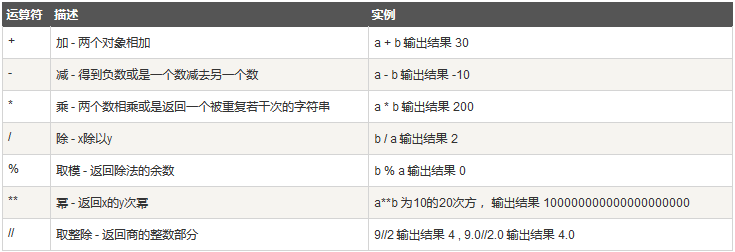
2.比较运算符
以下假设变量a=10,变量b=20:
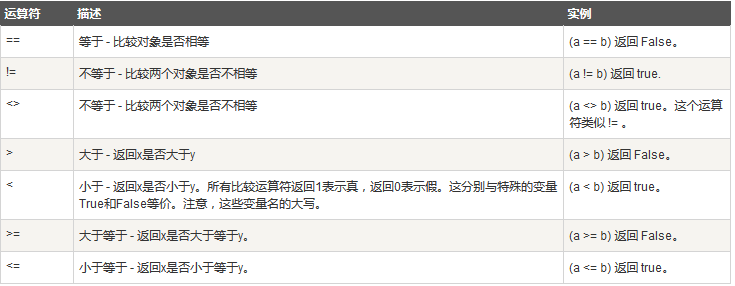
关于python中比较运算符使用的总结:
1.python中任意对象都可以比较
2.相同类型的对象(实例),如果是数字型(int/float/long/complex),则按照简单的大小来比较;如果是非数字型,且类(型)中定义了__cmp__(含__gt__,__lt__等)则按照__cmp__来比较,否则按照地址(id)来比较。
3.不同类型的对象(实例),如果其中一个比较对象是数字型(int/float/long/complex等),则数字型的对象<其它非数字型的对象;如果两个都是非数字型的对象,则按照类型名的顺序比较,如{} < "abc"(按照"dict" < "str"),而"abc" > [1,2], "abc" < (1,2)。
4.对于自定义的类(型)实例,如果继承自基本类型,则按照基本类型的规则比较(1-3)。否则,old-style class < new-style class, new-style class之间按照类型名顺序比较,old-style class之间按照地址进行比较。
3.赋值运算符
以下假设变量a=10,变量b=20
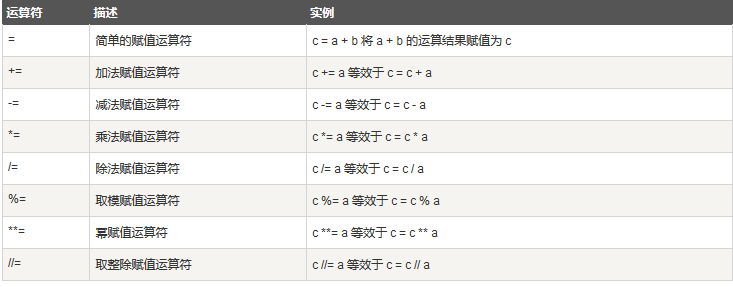
4.位运算符
按位运算符是把数字看作二进制来进行计算的。Python中的按位运算法则如下:
下表中变量 a = 60,b = 13
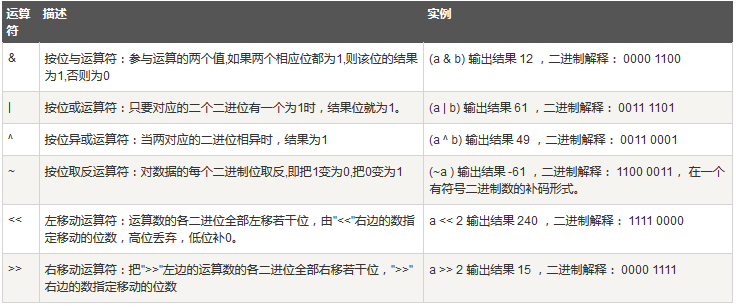
5.逻辑运算符
以下假设变量 a = 10, b=20

6.成员运算符
除了以上的一些运算符之外,Python还支持成员运算符,测试实例中包含了一系列的成员,包括字符串,列表或元组。

7.身份运算符
身份运算符用于比较两个对象的存储单元

这里要讲讲python中的内存池(缓冲池)了,python使用内存池来管理小的整型数和小的字符串等等。
什么意思呢?
当我们执行以下赋值运算时
a = 123
b = 123
理论上是要分别在内存中创建两个值,然后赋值给变量的,但是这样做实在是有点浪费,明明是一样的数,却要占用两个内存空间。
所以python为了节约内存,引入了内存池,当小的整型(-5~257,不包括257)要多次创建时,只创建一次,后面的都将引用指向同一个地方,此时使用身份运算符会出现:
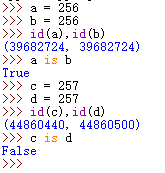
字符串的则以256个ascll码为分界
有兴趣的可以参考:戳这里
8.运算符的优先级
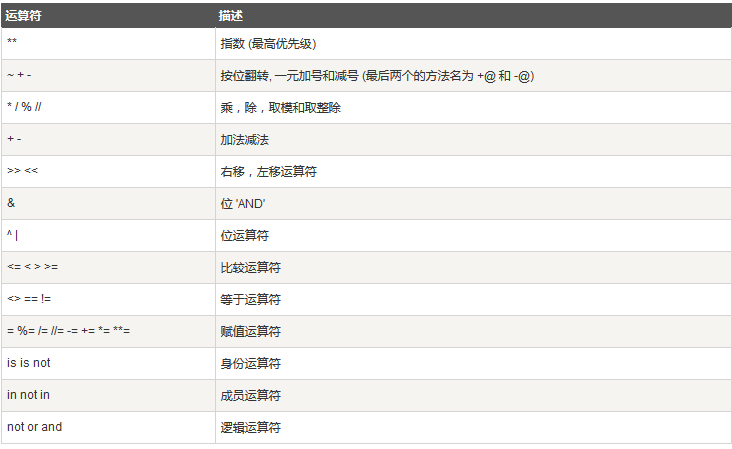
另外,我们也可以像数学一样使用括号() ,来指定某个运算先进行
更多参考:戳这里
有别人做好的轮子就是不一样,一路复制粘贴就好了,真轻松。
二、长整型
和整型基本一样,这里就不重复了。自己可以用 help() 函数查看。
遇事不决喊救命
三、浮点型
这里就不全部列举了,只讲讲不同的。
| __setformat__(...) | float.__setformat__(typestr, fmt) -> None | | You probably don't want to use this function. It exists mainly to be | used in Python's test suite. | | typestr must be 'double' or 'float'. fmt must be one of 'unknown', | 'IEEE, big-endian' or 'IEEE, little-endian', and in addition can only be | one of the latter two if it appears to match the underlying C reality. | | Override the automatic determination of C-level floating point type. | This affects how floats are converted to and from binary strings.
一个内部方法,用于内部测试的,官方都说了You probably don't want to use this function(你可能不想使用这个函数),而实际上我们也用不到,我也不知道有什么用,一般可以无视。
| __trunc__(...) | Return the Integral closest to x between 0 and x.
返回最接近x从0积分和x,貌似和积分运算有关,没用过
| as_integer_ratio(...) | float.as_integer_ratio() -> (int, int) | | Return a pair of integers, whose ratio is exactly equal to the original | float and with a positive denominator. | Raise OverflowError on infinities and a ValueError on NaNs. | | >>> (10.0).as_integer_ratio() | (10, 1) | >>> (0.0).as_integer_ratio() | (0, 1) | >>> (-.25).as_integer_ratio() | (-1, 4)
返回一个由两个数字组成的元祖,而两个数字相除就等于原浮点数,其实就是返回一个最简分数,分子在前面,分母在后面。
| conjugate(...)
| Return self, the complex conjugate of any float.
返回本身的共轭复数
| fromhex(...) | float.fromhex(string) -> float | | Create a floating-point number from a hexadecimal string. | >>> float.fromhex('0x1.ffffp10') | 2047.984375 | >>> float.fromhex('-0x1p-1074') | -4.9406564584124654e-324
用一个十六进制的字符串来创建一个浮点数
| hex(...) | float.hex() -> string | | Return a hexadecimal representation of a floating-point number. | >>> (-0.1).hex() | '-0x1.999999999999ap-4' | >>> 3.14159.hex() | '0x1.921f9f01b866ep+1'
上面方法的逆运算,返回一个浮点数的十六进制表示的字符串
| is_integer(...) | Return True if the float is an integer.
判断一个浮点数是否为整数

其实就是看小数位是否都为0
四、复数
都是一些运算和内置函数相关的,唯一特别的是
| conjugate(...) | complex.conjugate() -> complex | | Return the complex conjugate of its argument. (3-4j).conjugate() == 3+4j.
返回一个原复数的共轭复数





















 408
408











 被折叠的 条评论
为什么被折叠?
被折叠的 条评论
为什么被折叠?








